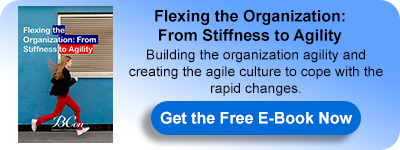The Cornerstones of Business Agility
When circumstances need change, organizational agility is a cultivated capability that allows the organization to make timely, effective, and long-term changes. Agility, also known as a dynamic capability, refers to a company's ability to detect opportunities and threats, solve problems, and transform its resource base.

As illustrated above, organization agility is built on a solid foundation of sound management. Traditional goal formulation, resource allocation, and human resource practices have little chance of being agile if a business cannot design and run them. Agile firms also understand that these systems must be able to adapt to change. When the need for change is unpredictable and frequent, annual budgeting and performance review methods are inflexible.
By contrast, Agile organizations design their management procedures to bend and evolve to support continuous performance. As a result, management processes are faced with the task of guiding current performance while also leading the growth of innovation and the production of new value that will produce future profits.
In what is known as an ambidextrous company, management practices in agile businesses must promote both efficiency and creativity.
Secondly, the most significant resource base for organizational agility is the set of differentiated capabilities that express the organization's current strategy and drive current performance.
Most firms invest in winning talents to strengthen their reliability and make them costly and difficult to copy to assist in the building of a durable advantage.
While such expenditures frequently produce higher current returns, they also make organizational change more challenging and result in adaptive patterns that mirror successes from the past that may be obsolete today.
Agile organizations, on the other hand, understand that focusing on today's plan — and its underlying capabilities — is a waste of time. They constantly acquire the essential skills, information, organizational systems, architecture, and experience to carry out the current plan and design and support prospective new capabilities.
Finally, at the top of the pyramid, there are agile four routines, which tell when, where, and how the change needs to happen to sustain the performance of the organization as shown below:


One of the routines is Strategizing. Top management teams control the organization's atmosphere and commitment to implementing organizational change and broadly shared short- and long-term strategies with a shared purpose. The next is perceiving routine. It explains how companies are intended to monitor the external environment and pass these perceptions to decision-makers for interpretation for making the right and agile decisions. The testing routine is about to continue trying while failing until succeed. People are encouraged to try new things, and keep learning from their failures to be prepared to achieve innovation in an agile manner. Finally, the implementation routine explains how the organization keeps its capability to change by implementing the organizational changes supported by leadership and human resource management systems.
Notably, the entire system of routines confers agility and sustains performance, not just one or two of them. Organizations that had three or four of the procedures had a seven-fold higher chance of maintaining above-average profitability3. These routines may appear simple on their own, but the effort required to arrange them for consistently high performance is sophisticated and uncommon.
While the four agility routines explain persistent, above-average performance, they don't explicitly describe how organizations change to agility or how, for example, they move ideas from perception to testing to implementation. The AWS model accomplishes this and provides a valuable complement to the management processes required to comprehend change, innovation, and agility.
1 Quality & Equality, Accessed 15 April 2022, What is Organizational Agility: A Conversation with Chris Worley https://www.youtube.com/watch?v=3kuMESQUl2U
2 Management processes for agility, speed, and innovation, Stuart Winby, Christopher G. Worley b, Accessed 20 April 2022, https://starlab-alliance.com/wp-content/uploads/2017/09/Mgmt-Processes-for-Agility-Speed-Innovation-Winby-and-Worley.pdf
3Management processes for agility, speed, and innovation, Stuart Winby, Christopher G. Worley b, Accessed 20 April 2022, https://starlab-alliance.com/wp-content/uploads/2017/09/Mgmt-Processes-for-Agility-Speed-Innovation-Winby-and-Worley.pdf
For more about this topic, download our latest book " Flexing the Organization: From Stiffness to Agility " for FREE:
